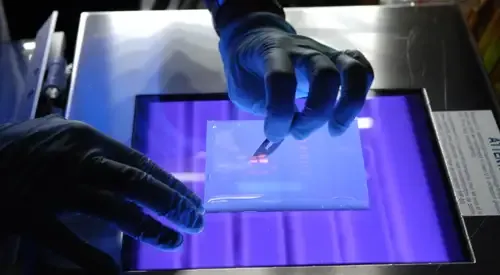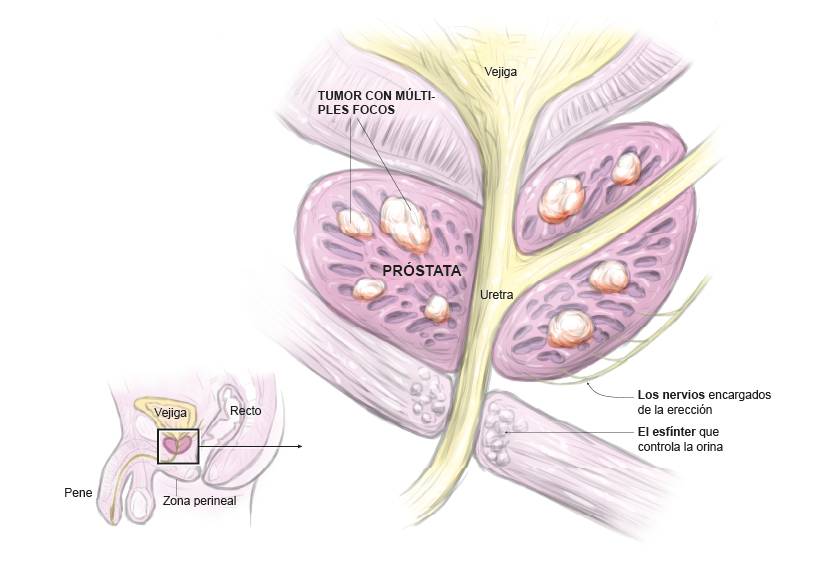Cancer of the prostate
"We have the most advanced diagnostic tools for prostate cancer".
DR. BERNARDINO MIÑANA
DIRECTOR - PERSON IN CHARGE. UROLOGY DEPARTMENT

What is prostate cancer?
Prostate cancer is a malignant degeneration of the prostate that occurs mainly in men over 65 years of age. The prostate is a gland of the male reproductive system, located below the bladder and whose function is to generate seminal fluid.
It is the most common cancer in men in the European Union, although it is very rare under the age of 50. Advances in early detection programmes and imaging techniques make it possible to diagnose the disease in early stages, which increases the chances of cure.
Similarly, in the field of surgery and radiotherapy there have been advances that mean that the current treatment for localised prostate cancer has a 10-year survival rate of almost 100% of patients.
At the Clínica Universidad de Navarra Cancer Centre we have a Prostate Cancer Department, where we offer our patients a multidisciplinary approach to the disease. The joint or sequential action of the different specialties involved is the ideal scenario to guide and treat the disease.
This area carries out, among other actions, an Early Detection Programme for men over 50 years of age. These programmes are of vital importance as, on many occasions, prostate cancer does not produce symptoms and is detected in routine check-ups.

A PERSONALIZED MEDICINE
Second Opinion,
peace of mind
Request a second opinion from our professionals with great experience in the diagnosis and treatment of oncological diseases
In 3 days, without leaving home.
What are the symptoms of prostate cancer?
Do you have any of these symptoms?
If you suspect that you have any of the above symptoms,
you should consult a medical specialist for a diagnosis.
What are the causes and risk factors?
- Age is one of the main risk factors for prostate cancer. In fact, more than 70% of cases occur in men over the age of 50.
- Another aspect to take into account is the existence of genetic factors. Family history doubles the risk of developing the disease, especially when two or more direct first-degree relatives (father or brothers) are affected by prostate cancer.
- Health habits also influence the possible appearance of prostate cancer and are closely related to poor nutrition, obesity and a sedentary lifestyle.
- Smoking is another factor that can favour the appearance of this cancer, as it increases hormone secretion, which causes the tumour to grow.
- Race is another risk factor. It occurs about 70% more often in African-American men.
Precision in the diagnosis of the location
and malignant potential of prostate cancer

Combine Multiparametric Magnetic Resonance Imaging (MRI) with biopsy to achieve three objectives:
- To know if the patient has prostate cancer with maximum safety avoiding second biopsies.
- Locate the tumour within the prostate.
- Obtain samples directly from the tumour, which allows us to know its biology in the most precise way, which is necessary to apply a treatment proportional to the severity and extent of the disease.

This is an imaging test used to detect sites of disease recurrence. In patients with high-risk tumours, in which the cancer can leave the prostate, we perform an extension study, with a choline PET.
This is a very sensitive test that allows us to adapt the treatment to the patient's characteristics. By combining it with fusion biopsy, we have been able to treat patients with high-risk tumours with complete preservation of continence and sexual function.

PET PSMA is a diagnostic imaging technique used to detect prostate cancer in a very early stage, or in relapses. It is also one of the newest techniques.
It tells us exactly where the tumour is located, even before it is visible with other techniques, which allows us to standardise recurrence patterns and the most appropriate treatment for each one.

In addition to imaging tests, we carry out a molecular diagnosis determining biomarkers to evaluate which patients can benefit from conservative treatments and to assess the possibility of performing personalized treatments in patients with advanced tumors.
How is prostate cancer treated?
For prostate cancer limited to the gland, which has not spread according to previous clinical tests, we can offer the following treatments in addition to the active surveillance we apply in selected cases.
Focal therapy
This involves treating the diseased part of the prostate with a safety margin to control the tumour while preserving continence and sexual function. To do this, we use irreversible electroporation, high-intensity focused ultrasound (HIFU) or high-rate brachytherapy depending on the location of the tumour.
We are pioneers in this approach and have the best follow-up series in the country. We have managed to control the tumour in 96% of cases in the treated area, preserving continence in 100% and erections in 96%.
Da Vinci® robot-assisted radical prostatectomy
Although we also perform this procedure by pure laparoscopy in selected cases, robotic surgery offers the maximum guarantee for our patients due to its high precision and rapid recovery.
We have a continence rate close to 100% at present and a preservation of sexual potency that depends on the aggressiveness of the tumour, its location and the age and previous diseases of the patient.
When the conditions of the tumour and the patient are favourable, the preservation of sexual potency is greater than 90%, with or without associated drugs.
High and low rate brachytherapy in monotherapy
Brachytherapy is used either to treat the whole prostate or the affected part with a safety margin (focal therapy).
With the low-rate technique, we introduce radioactive iodine or palladium seeds via the transperineal route into the selected areas, which take effect over several months.
With the high-rate technique we administer the full dose, from a radioactive Iridium source, in two sessions separated by 12 hours so that the patient receives the full dose before being discharged 24 hours after admission.
External radiotherapy with V-MAT
This is a form of intensity-modulated radiotherapy in which the radiation is administered with a unit that rotates 360º, allowing it to adapt to the volume and shape of the prostate, achieving the desired doses with minimal radiation to the surrounding tissues. Compared to more conventional forms of external radiotherapy, this treatment is more precise, quicker and has fewer adverse effects.
External radiotherapy with proton therapy
Proton therapy provides us with the maximum guarantee of reaching the appropriate doses with maximum respect for the surrounding tissues and, therefore, the possible adverse effects.
The information provided by the Ga-PSMA PET allows us to detect early, after the failure of a previous treatment such as surgery, radiotherapy, or both—indicated by a rising PSA level—the exact location of the recurrence.
Again, MRI and fusion biopsy enable us to confirm the presence and biology of the tumor, an essential step before planning any salvage treatment, always with a minimally invasive approach.
We have been pioneers in the management of patients with local or lymph node recurrence using robotic surgery, transurethral resection, and SBRT radiotherapy.
Some patients may benefit from irreversible electroporation or high-dose-rate brachytherapy, depending on tumor location and previous treatment.
Since there is no prior global experience, all these treatments are considered experimental and are part of a prospective study approved by the Ethics Committee.
In metastatic prostate cancer we are able to detect the disease with PSMA PET. Early detection with PET allows us to apply earlier systemic treatments, either with therapies targeting androgen receptor-dependent growth; or with systemic chemotherapy; or through inclusion in some of the cutting-edge clinical trials in which we participate.
It has been shown that the earlier the treatment with these agents, the greater the expected benefit.
What clinical trials do we have on Prostate Cancer?
Where do we treat it?
IN NAVARRA AND MADRID
The Prostate Cancer Area
of the Cancer Center Clínica Universidad de Navarra
We provide the patient with a medical team, made up of first class professionals, and state-of-the-art diagnostic and therapeutic means such as Da Vinci® robotic surgery.
The Urology Department, which is part of the Prostate Cancer Area, has the accreditation certificate of the European Board of Urology, a reinforcement of the excellence of the service at the level of care, teaching and research, which only three hospitals in Spain have.
No other institution in this country, and few in the world, has all the combination of state-of-the-art diagnostic means that allow us to find out what is specific to the disease in each patient in order to offer the most personalized treatment possible.
Diseases we treat:

Why at the Clinica?
- A team of top-level professionals trained in international centers.
- State-of-the-art technology for diagnosis and treatment.
- In 24-48 hours you can start the most appropriate treatment.





































